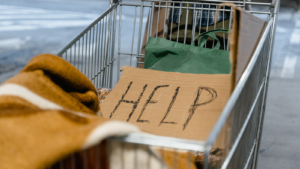Homelessness is a difficult issue that affects many people, but there are a lot of myths and misunderstandings about it. These myths can create stigma and make it harder for people to get the help they need. In this blog, we’ll clear up some of the most common myths about homelessness and share facts to help people understand the issue better. We’ll also take a look at homelessness in Indiana and Morgan County, where the problem is growing.
Myth #1: Homelessness Is Caused by Laziness or Poor Choices
A common belief is that people who are homeless are lazy or don’t want to work. In reality, homelessness is often caused by things beyond a person’s control. Many people become homeless because they lose their job, can’t afford housing, go through a family crisis, or face mental health issues. According to a Q&A from NYU, people experiencing homelessness often face many challenges that make it hard to get back on their feet.
Fact: Homelessness is often the result of tough situations like job loss, high rent prices, or family problems, not laziness or poor choices.
Myth #2: Most Homeless People Are Addicts or Mentally Ill
It’s a stereotype that most homeless people struggle with addiction or mental illness. While some do face these challenges, many people who are homeless do not. The Q&A from NYU explains that the main reason people experience homelessness is financial hardship. Most people are just struggling to make ends meet.
Fact: Only a small percentage of people who are homeless have severe addiction or mental health issues. For most, the problem is that they can’t afford housing.
Myth #3: Homeless People Choose to Live on the Streets
Some people think that people who are homeless prefer to live on the streets, but that’s not true. Most people want a stable home. However, they often face many obstacles that make it hard to find a safe place to stay. Shelters can be full, unsafe, or not available in some areas, so some people may choose to stay outside if they feel it’s the only option.
Fact: Most people experiencing homelessness want a stable home. They often stay on the streets because shelters are full or unsafe.
Myth #4: Homelessness Only Affects Certain People
Some people think homelessness only affects certain groups, like people living in big cities or people who have a certain background. However, homelessness can happen to anyone, including families, children, veterans, and people with jobs. The lack of affordable housing and rising rent costs are major reasons for homelessness, even in smaller towns and rural areas.
Fact: Homelessness can affect anyone—families, kids, workers, and people from all walks of life.
Myth #5: Homelessness Is a Simple Problem People Can Fix on Their Own
Some believe that if people experiencing homelessness just work harder, they can solve their problems. But it’s not that simple. Homelessness is tied to bigger issues like lack of affordable housing, not enough jobs with good pay, and limited access to healthcare. People need support from their community to get back on their feet.
Fact: Homelessness is a complex issue that needs help from communities and organizations. It’s not something people can fix alone.
Homelessness in Indiana and Morgan County
Homelessness isn’t just a big city problem. In Indiana, there were 4,398 people experiencing homelessness in 2023, a significant increase from the year before. Many of these people are families with children, and most are struggling because they cannot afford housing. In Morgan County, about one-third of households are having trouble meeting basic needs like rent and food. These numbers show how serious the issue is, even in smaller communities.
Fact: In 2023, 4,398 people were homeless in Indiana, and in Morgan County, many families are struggling to make ends meet because they can’t afford housing.
Conclusion
It’s important to understand the real reasons behind homelessness so we can be more supportive of those who are struggling. By learning the facts and challenging the myths, we can help create a more compassionate society. Homelessness is a complicated issue, but with the right support and resources, people can find their way to stability and a better future.
Sources:
NYU, “Understanding Homelessness: Myths vs. Facts,” https://www.nyu.edu/about/news-publications/news/2019/september/HomelessQandA.html
Indiana Housing and Community Development Authority, “2023 Homeless Population Count and Demographics,” https://www.in.gov/ihcda/files/ihcda_CoC_PIT_FLYER_082423.pdf
WRTV, “Smaller central Indiana communities seeing an increase in homeless families,” https://www.wrtv.com/news/local-news/smaller-central-indiana-communities-seeing-an-increase-in-homeless-families



